#Google MUM AI content for search engines
Text
youtube
GoogleMUM #algorithm #search #seo #update #seoai
https://www.seolady.co.uk/google-mum-update-ai-ranking-seo-nlp-multitask-unified-model/ What is Google MUM and when was it updated in 2023?
content #naturallanguageprocessing #AI #Ranking
Multitask Unified Model MUM: Google developed its Natural Language Processing NLP - Does This Mean A New Way for SEO?
★ Originally dubbed "BackRub", the baby Google was the result of a research project that started back in 1996. Which means in 2026, technically, Google will be 30 years old. Do you remember Ask Jeeves, Netscape and Yahoo chat rooms? MSN chat and My Space with Tom?
In 2023, MUM uses natural language processing (NLP) and deep learning techniques to interpret complex questions and return highly relevant results. Google has famously been tight lipped with most new releases, from their blog the first announcement was in 2021.
★ It was created to address the growing need for more advanced search capabilities and to provide better experiences for users seeking information. ChatGPT AI was generally released in November 2022, and the SEO circles around the world are keeping MUM at the forefront of their curiosity in 2023.
★ https://www.seolady.co.uk/seo-keyword-research-chatgpt-search-phrases-long-tail-synonyms/
The MUM update is Google’s new AI language model that uses natural language processing to improve search results. This model allows Google to understand more complex queries, and it can help provide more accurate and relevant search results. MUM can also understand and translate between multiple languages, making it a powerful tool for international search.
★ According to Google, the MUM update is 1000 times more powerful than its previous BERT update, which was already a significant improvement in natural language processing. With MUM, Google can understand longer and more complex queries, making it easier for users to find what they’re looking for. This update also brings new features like a new search experience with dynamic layouts and visual search, so users can find the information they need faster and more efficiently.
website #multitaskunifiedmodel #bert #nlp #searchqueries #machinelearning
#AI Keyword research SEO#Using natural language AI eCommerce Google#Google MUM AI content for search engines#Google MUM latest update#Google MUM 2023 NLP#Multitask Unified Model MUM#Google Natural Language Processing NLP#Generating topic clusters using AI for SEO content#Google MUM and writing for readers#AI content 2023 niche SEO#niche SEO content writing#niche SEO tips#Youtube
1 note
·
View note
Text
TOP SEO TRENDS TO RANK YOUR WEBSITE

In today’s digital age, having a website is essential for any business to establish an online presence. However, creating a website alone is not enough to attract potential customers to your site. Search engine optimization (SEO) is crucial to improve your website’s visibility in search engine results pages (SERPs). As search algorithms and user behavior continue to evolve, staying updated with the latest SEO trends is vital to ensure that your website ranks well in search engines. In this article, we will discuss the top SEO trends that you need to know to improve your website’s ranking. By implementing these trends in your SEO strategy, you can enhance your website’s online visibility and drive more organic traffic to your site.
WHAT ARE SEO TRENDS AND WHY DO YOU NEED TO KNOW THEM?
SEO trends refer to the latest techniques and strategies that website owners, digital marketers, and SEO professionals follow to improve their website’s ranking in search engine results pages (SERPs). These trends are constantly evolving as search algorithms and user behavior changes, so it’s crucial to stay updated with the latest trends to ensure that your website remains relevant and visible to potential customers.
By following SEO trends, you can improve your website’s online visibility, attract more organic traffic to your site, and ultimately increase your business’s revenue. For example, if you implement multimedia content promotion, such as adding videos with transcripts to your website, it can significantly increase traffic to your site. This can result in more people discovering your brand and potentially becoming customers.
An example of how following SEO trends can affect website traffic is the Almco project we are currently working on. By adding a video with a transcript as a blog post, the page began to show up in Google Discovery, which significantly increased the website’s traffic.

This is an example of how following SEO trends, such as multimedia content promotion, can positively impact a website’s traffic and ultimately the success of the business.
HOW TO KEEP UP WITH SEO TRENDS?
Staying up-to-date with SEO trends is essential to ensure that your website remains visible and competitive in search engine results pages (SERPs). Here are some ways to keep up with SEO trends:
Hire an SEO specialist: an experienced SEO specialist can help you stay up-to-date with the latest trends and techniques in search engine optimization.
Communication among other specialists: network with other SEO professionals and attend industry events to stay informed about the latest trends.
Read industry sources: read blogs and websites such as Search Engine Journal, Moz, and Search Engine Land to keep up with the latest news and trends in SEO.
Subscribe to industry newsletters: subscribe to newsletters from industry experts and publications to receive the latest updates on SEO trends and techniques.
Monitor search algorithm updates: keep an eye on major search algorithm updates, such as Google’s MUM and Penguin updates, to understand how they may impact your website’s ranking.
By staying informed and implementing the latest SEO trends and techniques, you can improve your website’s visibility, attract more organic traffic to your site, and ultimately grow your business.
To learn more about our SEO services, visit the SEO Promotion Services page.
NEW SEO TRENDS IN 2023
As the digital landscape continues to evolve, new SEO trends are emerging in 2023 that businesses should be aware of. In the following paragraphs, we will explore some of these emerging trends and discuss how they are shaping the future of SEO.
AI becomes an important SEO tool
Artificial intelligence (AI) has become an increasingly important tool for SEO specialists in recent years, as it offers many benefits for content creation and optimization. ChatGPT is just one example of an AI-powered tool that can write text, generate unique product descriptions, and develop effective link-building strategies, among other things. Other AI tools available for SEO include Bing from Microsoft, Jasper, Anyword, and Rytr.
Companies such as CNN and Ukrainian retailer Epicentr have already started using AI-generated content to improve their productivity and create unique content faster. However, it’s important to note that AI has its limitations and cannot yet fully replace human SEO specialists. While AI can improve productivity and make SEO optimization faster and easier, it still requires human oversight and editing to ensure quality and accuracy. Overall, AI is a valuable tool for SEO specialists, but it should be used in conjunction with human expertise for optimal results.
One example of how AI-generated content can be effective is a case in which we used ChatGPT to create an article for a website. The article was indexed immediately, within one day, and began to bring traffic to the site. What’s particularly interesting about this case is that when we used an OpenAI tool for detecting AI-written articles, it showed that the article was generated by a human, despite the fact that it was actually written by ChatGPT. This demonstrates the high quality and authenticity of the content generated by AI tools like ChatGPT, and how it can seamlessly integrate into a website’s SEO strategy.

You may be interested: The impact of ChatGPT on marketing, advertising, SMM, and SEO
Showing Experience to comply with new EEAT requirements
In 2022, Google updated its Quality Rater Guidelines to emphasize the importance of expertise, authoritativeness, and trustworthiness (EAT) in website content. They added an additional “E” to EAT, making it EEAT. This means that now, in addition to expertise, authoritativeness, and trustworthiness, Google also considers first-hand experience to be a crucial aspect of a website’s content. To comply with this new requirement, it’s important for websites to have reviews, author bios, an “about us” page, and a privacy policy page. These elements can help demonstrate a website’s expertise, authoritativeness, trustworthiness, and first-hand experience. This is particularly important for sites in the YMYL (Your Money or Your Life) niche, but it’s important for all websites to take EEAT into consideration, as it can affect their traffic after a core update. To learn more about EEAT and how to demonstrate first-hand experience, check out the Google Search Central Blog and a very informative article from Search Engine Journal.
Importance of multimedia content
Adding multimedia content such as images to a website is crucial for a positive user experience and can also have a positive impact on SEO. It is important to use unique images and optimize them properly, including adding a title when saving the image, adding title and alt text in the admin panel, using images in the proper context, and saving metadata. This is especially important for local businesses to ensure that their images are properly indexed and appear in relevant local searches.
One option for creating unique images is to take your own photos, but there are also AI-powered tools available such as Midjourney, Stable Diffusion, and DALL-E. Out of these options, Midjourney we recommend as the best.
By incorporating video content on the website, you can also enhance the user experience and potentially improve SEO. Google has even included a separate tab for pages with video content, indicating its importance. It is recommended to create your own videos, even if they are simple, to make them unique. Tools such as Invideo, Synthesia, Elai, and Steve AI can help create and edit videos. Don’t forget to optimize videos by adding descriptions.
Voice search and the growing importance of low-frequency queries
Voice search is becoming increasingly popular and has changed the way people search for information. This means that SEO strategies should consider how people speak and formulate questions when using voice search, which may differ from how they would type the same query. As an instance, someone may use voice search to ask, “What are the latest SEO trends for 2022?” whereas typing in the words “2022 SEO trends.”
As for low-frequency queries, these are longer and more specific search terms that are not as commonly used but are highly relevant to the user’s search intent. SEO specialists should focus on these types of queries as they can have a higher conversion rate than generic, high-frequency keywords.
To optimize for voice search and long-tailed queries, SEO specialists should focus on creating high-quality content that directly answers the user’s question, using natural language that reflects how people speak in everyday conversations, and including structured data to help search engines better understand the content.
To learn more about our SEO services, visit the Free SEO Audit page.
Increasing the importance of your own research and publishing your own unique content
In today’s digital landscape, it is essential for companies to invest in conducting their own research, surveys, and experiments. Simply writing unique content is no longer enough to stand out from the competition. Rather, companies must provide their own unique information that cannot be found elsewhere on the internet. This means that articles should not only provide comprehensive information, but also offer insights and perspectives that are exclusive to the company. As a result, longer articles that go into greater depth are becoming increasingly valued in the industry.
In the case of Decks Toronto , we added an article with detailed information comparing two popular brands. The article contained a lot of unique criteria, technical information, and tables that were not readily available on the internet. This approach of conducting research and providing unique information in their content helped Decks Toronto stand out from their competitors and establish themselves as a credible source of information in their industry.

Learn more about SEO strategy for local e-commerce businesses in our article “SEO case study: strategy to overcome seasonality, PPC competition and niche crisis for local ecommerce business”
Optimizing for user’s intent
Optimizing for user intent involves analyzing the target audience and understanding their needs, questions, and problems, rather than simply optimizing for one keyword. This approach ensures that the article provides valuable and relevant information that meets the user’s search intent. By understanding the user’s intent, content creators can optimize their articles by using relevant keywords, structuring the content to answer specific questions, and providing valuable insights that address the user’s needs. This approach not only improves the user experience but also increases the chances of the article ranking higher in search engine results pages.
Semantic SEO optimization: knowledge graphs & entities
Semantic SEO optimization focuses on using contextual information and understanding the relationships between different entities to improve the relevance of search results. This involves optimizing for knowledge graphs and entities, which are the building blocks of information that search engines use to understand the meaning behind queries and content. By structuring your content in a way that aligns with the way search engines interpret and present information, you can improve the visibility and relevance of your website in search results.
For example, you can use schema markup to define the relationships between entities and provide additional context for search engines. This can help search engines understand the meaning behind queries and present more relevant results to users. Additionally, you can optimize your content for featured snippets and other rich snippets, which are designed to provide users with quick answers to their queries.
SEO TRENDS THAT ARE KEEPING THEIR IMPORTANCE IN 2023
While there are always new SEO trends emerging, it’s important to remember that the foundational elements of SEO are still critical to success. Further we will explore some of the common SEO trends that have been relevant in the past, are currently relevant, and are expected to continue to be relevant in the future.
Site loading speed and Core Web Vitals
In 2023, site loading speed and Core Web Vitals will continue to be important SEO trends. Core Web Vitals, which consist of three metrics – Largest Contentful Paint (LCP), First Input Delay (FID), and Cumulative Layout Shift (CLS) – are used to measure the user experience of a website. Improving these metrics can lead to a better user experience, which can result in better search engine rankings. Additionally, site loading speed plays a crucial role in both user experience and search engine rankings. Slow loading times can lead to increased bounce rates and lower rankings. Tools like PageSpeed Insights can help website owners identify areas for improvement and optimize their site for faster loading times. By prioritizing site speed and Core Web Vitals, website owners can improve their SEO and provide a better user experience for their visitors.
Recently, on the 24th of April, Google announced that they will no longer support some ranking signals, including Page Speed Insights. However, this does not mean that site speed is no longer important for SEO. Google’s intention is to encourage a holistic approach to website optimization and not to focus solely on numbers. Instead of Page Speed Insights, developers can use Google Lighthouse to measure the speed and performance of their sites. Additionally, SEO professionals can continue to use GTmetrix, which provides website speed test results and detailed performance reports.
High-quality content
High-quality content is an essential element of SEO, as it ensures that users find what they are looking for when they land on a website. Google’s “helpful content update” emphasizes the importance of creating content that is genuinely useful to users, answering their queries and providing helpful information. To create high-quality content, it’s important to research your topic thoroughly and use reputable sources. A clear and engaging writing style is also essential, as well as incorporating multimedia elements such as images and videos. Google provides guidelines for creating helpful content, which include prioritizing the user’s needs, ensuring accuracy and expertise, and creating content that is easy to understand and access. By creating high-quality content, websites can improve their rankings in search results and attract more traffic.
Linkbuilding
Link building is an important part of any SEO strategy and involves acquiring links from other websites to your own site. One effective way to start link building is by analyzing your competitors’ pages and identifying the websites that are linking to them. You can use tools like Ahrefs to check your domain rating and the number of referring domains pointing to your site.
In a case where we invested in low-budget link building, the results might not be immediately noticeable. However, after a few months, we started seeing an increase in traffic. This is because links from high-quality, relevant websites can help improve your website’s authority and search engine rankings.

It’s important to note that link building should be done carefully and with a focus on quality over quantity. Low-quality or spammy links can actually harm your website’s rankings and reputation. Instead, aim to build relationships with other website owners in your industry and create valuable content that others will want to link to naturally.
Mobile friendliness
Mobile friendliness is a critical aspect of website optimization, as more and more users access the internet from their mobile devices. To ensure that your website is mobile-friendly, you can use Google’s Mobile-Friendly Test tool, which analyzes your website’s pages and reports if they are designed to be viewed on mobile devices. The tool evaluates factors such as the text size, page loading speed, and responsiveness of your website on different mobile devices. By making your website mobile-friendly, you can improve the user experience for your mobile audience, boost your search engine rankings, and drive more traffic to your site.
On the 24th of April, Google announced that it will retire its Mobile-Friendly test tool. This tool has been used by many SEO professionals to check if their website is mobile-friendly. However, this announcement does not mean that responsible design is not important. Developers from Google want SEO to focus on a more holistic approach rather than just numbers. They recommend using other tools, such as the Mobile Usability report in Search Console, to ensure your website is mobile-friendly. This change is in line with Google’s focus on improving user experience on the web.
Targeting the audience and its needs, not bots
In the world of SEO, it’s important to remember that we write for people, not just for search engine bots. In the past, there was a tendency to focus too much on keyword density and stuffing pages with exact-match keywords in order to rank higher. However, with Google’s implementation of the BERT algorithm, the focus has shifted to understanding the context of the content and providing value to the reader. This means that you can focus on creating high-quality content that addresses the needs of your target audience, rather than worrying about exact keyword matches. By crafting content that is relevant, engaging, and informative to your audience, you’ll be able to build trust and credibility, ultimately leading to higher rankings and better engagement.

IM4U DIGITAL MARKETING AGENCY WILL HELP YOU TO STAY UP-DO-DATE ON SEO TRENDS
Don’t let your website fall behind in search engine rankings. Trust IM4U Digital Marketing Agency to keep you up-to-date with the latest SEO trends and strategies. Book our SEO website audit now and watch your website climb to the top of the search results. Contact us to learn more!
#seo#search engine optimization#website ranking#search algorithms#video content#voice search#long-tail keywords#high-quality content#website loading speed#core web vitals
4 notes
·
View notes
Text
youtube
Watch the 2024 American Climate Leadership Awards for High School Students now: https://youtu.be/5C-bb9PoRLc
The recording is now available on ecoAmerica's YouTube channel for viewers to be inspired by student climate leaders! Join Aishah-Nyeta Brown & Jerome Foster II and be inspired by student climate leaders as we recognize the High School Student finalists. Watch now to find out which student received the $25,000 grand prize and top recognition!
#ACLA24#ACLA24HighSchoolStudents#youtube#youtube video#climate leaders#climate solutions#climate action#climate and environment#climate#climate change#climate and health#climate blog#climate justice#climate news#weather and climate#environmental news#environment#environmental awareness#environment and health#environmental#environmental issues#environmental education#environmental justice#environmental protection#environmental health#high school students#high school#youth#youth of america#school
17K notes
·
View notes
Text
The Unanswered Mysteries of Google Search: 12 Questions SEO Experts Ponder

Before we do questions...
Google's algorithm is updated thousands of times a year, making search results a constantly shifting landscape for website owners and SEO professionals.
With over 3.5 billion searches conducted daily, Google holds immense power over what web users discover (Search Insights 2024). Yet, some elements of how it decides rankings remain a mystery.
Think you know how Google crawls the web? You might be surprised by the secret rules its bots follow, impacting what pages make it to the top search results.
However, some aspects of how Google determines search rankings remain shrouded in secrecy. The search giant plays its cards close to the chest, leaving SEO experts to wonder about the inner workings powering the world's most popular search engine.
In this article, we'll explore 10 of the most intriguing unsolved mysteries perplexing SEO professionals today. While definitive answers may not yet exist, pondering these uncertainties offers valuable perspective into the ever-evolving art and science of SEO.
The Core Algorithm
Question 1: What is the precise weighting and hierarchy of Google's hundreds of ranking factors?
Google is known to utilize over 200 ranking signals, but the individual weight and priority order assigned to each remains unclear. Does content relevance still reign supreme? What about authority, user experience, and trust factors? SEO experts can only speculate on the behind-the-scenes calculations.
Question 2: How does the algorithm interpret the nuances of natural language and subtle quality signals within content?
Google's algorithms have advanced to grasp semantics, distinguish voice and tone, and identify expertise on niche topics. But the extent of its comprehension abilities - and how these interpret delicate context-based signals - is debatable.
Question 3: How extensively does semantic search and knowledge graphs impact rankings?
Google's increasing use of semantic search and knowledge graphs has opened new possibilities in how search results are generated and ranked. Rather than relying solely on keywords and page content, Google can now analyze the underlying meaning and relationships between concepts.
However, the extent to which semantic capabilities directly influence rankings is still uncertain. There are a few key factors to consider:
- For many informational queries, Google displays a knowledge graph panel summarizing key entities related to the search. Ranking well for entities increases the chances of appearing in these panels.
- Semantic search allows Google to better match pages to search intent, even when different terminology is used. But keywords still carry weight, especially for commercial intent queries.
- Pages optimized for semantic search can rank well even without exact keyword matches. But content, authority, links and other traditional factors still contribute significantly to rankings.
Penalties, Filters, and the Sandbox
Question 4: Can SEOs reliably detect the application of manual penalties or algorithmic filters in real-time?
When Google applies a manual spam action or algorithmic filter to a site, detection is often delayed. SEOs typically notice ranking volatility weeks later, unable to pinpoint causes. Improved methods for identifying penalties are needed.
Question 5: Does the Google "Sandbox" exist, and if so, what are its precise mechanics and triggers?
Many believe Google quarantines new sites, cautiously evaluating them before granting full indexation and rankings access. Circumventing this "Sandbox" effect could accelerate new site climbs, if true dynamics were known.
The Influence of User Data & AI
Question 6: How will MUM reshape search results and reliance on keywords?
MUM (Multitask Unified Model) is Google's most advanced AI system to date for natural language processing. With MUM, Google can better interpret search intent and make connections between concepts even when terminology differs between the query and content.
Specifically, MUM could impact search results and keywords in these ways:
- For conversational queries, MUM will become better at inferring the underlying informational need and returning relevant results. Keyword matching may become less important.
- MUM's cross-lingual abilities allow understanding across languages. Search results could become less reliant on exact keywords and more on meaning.
- MUM's breadth of knowledge may allow Google to return high-quality results even for obscure long-tail queries where keyword targeting is typically needed.
However, MUM is unlikely to make keywords obsolete. Keywords still indicate relevance, and targeting topics people search remains crucial. But MUM reduces the need for exact keyword matches. Overall search is likely to shift toward semantic intent matching rather than just keywords.
Question 7: To what granular level does Google personalize search results, factoring in past user behavior?
Google tailors some results to individual users, but the particular customization logic applied remains ambiguous. SEOs wonder: How unique are the SERPs each searcher sees?
Question 8: How will the evolution of AI models like LaMDA reshape how Google delivers search results in the coming years?
Google's AI initiatives like LaMDA point to a shift from keywords to semantic search. But the extent of AI's impact on rankings remains speculative. SEOs are eager to see what emerges.
Human Feedback & Local Search Mysteries
Question 9: How heavily do Search Quality Raters' evaluations influence the core algorithm, and what specific criteria do they use?
Google employs human raters, but their exact role in shaping rankings is uncertain. Increased transparency into their rating guidelines would offer useful insights for SEOs.
Question 10: What is the ideal, elusive blend of factors that propel a business to the top of local search results?
Myriad signals influence local rankings, from reviews to proximity to prominence. But determining the perfect recipe to outrank competitors in the Local Pack eludes most local SEOs.
Defense and Competitive Dynamics
Question 11: Does Google possess systems to proactively detect and nullify attempts at negative SEO?
Some speculate Google has technologies to identify and neutralize negative SEO attacks before they take effect. This capability, if confirmed, would ease common black hat fears.
Question 12: When two very similar pages have vastly different rankings, what are the minute differentiating factors Google has likely detected?
SEOs often find pages with nearly identical attributes, but hugely disparate rankings. Reverse engineering the granular reasons for this presents a perpetual riddle.
Conclusion
While Google keeps its cards close regarding the inner workings of its algorithms, the quest to better understand ranking factors and dynamics continues. As search engine technology progresses, new mysteries will surely emerge. But for SEOs, that's part of the fun - and the challenge.
The obscurities surrounding Google Search engine only underscore the need for comprehensive, ever-adapting SEO strategies. Despite the unknowns, SEO practitioners must continue leveraging research and critical thinking to make smart decisions, benefiting websites and users alike. The answers to today's uncertainties may reveal themselves in due time. Until then, pondering the possibilities is part of the ongoing journey.
Read the full article
0 notes
Text
Decoding Google's Algorithms: Sage Insights for SEO Success

In the nuanced world of SEO, the strategic use of long-tail keywords can be a game-changer. This expert guide delves into the effective utilization of long-tail keywords for significantly improving search engine optimization. Offering sage advice, it equips readers with the knowledge to tap into this underutilized resource, enhancing their website's visibility and reach.
At the core, Google’s algorithms aim to deliver the most relevant and reliable search results to queries. Through artificial intelligence and neural networks analyzing links, content and engagement metrics, pages earn rankings based on usefulness to searchers. However, as techniques advance rapidly, keeping pace with innovations poses a spiraling challenge.
Four major innovations – Hummingbird for semantic search, RankBrain for contextual understanding, BERT for natural language processing, and recent MUM neural networks – demonstrate Google’s relentless evolution. Tactics that worked yesterday through targeting keywords now fade behind relevance focused on understanding real meaning and value.
This algorithmic arms race means SEO requires a commitment to continuous learning, testing and optimizing to stay visible. Brands treating SEO as a one-time initiative find themselves drowned out over time. However, those closely studying algorithm signals via tools and their own site’s performance data can adapt faster.
In essence, rather than a defined rulebook, prevailing with Google necessitates an algorithm-oriented mindset – deciphering the “why” behind ranking fluctuations to reverse engineer success. Though the formulas stay secret, Google’s public guidance combined with insights from metrics and competitor monitoring illuminates the path forward. Committing to this learning cycle holds the keys to unlocking the search engine’s potential.
Brief History of Google Algorithm Innovations
Since its founding, Google has been at the forefront of search algorithm innovation, pioneering new techniques that have shaped the industry. A few landmark developments stand out as transformative in enabling Google to understand webpages and match them to search queries with increasing sophistication.
Arguably the most fundamental was PageRank, introduced in 1998. Conceived by co-founders Larry Page and Sergey Brin, PageRank helped revolutionize search by using the link structure of the web to assess the importance and authority of webpages for the first time. The intuition was that pages linked to by many other high quality pages should rank more highly in results. This allowed moving beyond just keyword matching to determine relevance.
Later, Google took a major leap into personalization and artificial intelligence for improved search context with its RankBrain algorithm in 2015. Using machine learning, RankBrain analyzes language patterns to better interpret the meaning and intent behind queries on the fly. It matches conceptual relevance beyond just keywords, powering the semantic capabilities in modern search experiences.
Building on these semantic foundations, innovations like Google's Hummingbird update in 2013 focused specifically on parsing queries in more natural language conversational ways. Rather than just keywords, algorithms could now interpret full sentences and questions to deliver relevant content. This paved the way for the rise of voice search and assistants.
And most recently, the company's BERT algorithm leveraged neural networks for a deeper understanding of language context and meaning, enabling even more intuitive matching of searches to helpful information across Google's vast index. It demonstrated how AI is driving the latest algorithm advances.
Together, these innovations in web crawling, personalization, semantics and AI propelled Google's algorithms to new frontiers in approximating human levels of query understanding and content comprehension. They set the stage for search to keep getting smarter.
Major Google Algorithm Factors and Signals
Google utilizes a complex array of algorithms powered by artificial intelligence to assess millions of signals across pages and websites. However, experts have identified certain vital factors and metrics that appear most influential in determining search rankings and visibility. These include page speed, authority metrics, semantic relevance, and E-A-T assessments.
As Google indexes primarily on mobile, delivering fast loading experiences is mandatory. Their metrics like Core Web Vitals grade site speed performance to reward faster sites with higher visibility. Optimizing pages for quick mobile loads improves rankings.
Additionally, authority signals like backlinks from reputable sites indicate endorsement and influence. More references from trusted domains imply greater subject matter expertise worthy of surfacing for users. Backlinks are votes of confidence in content quality and brand credibility that Google counts heavily.
Relevance to search intent also factors prominently. Ranking highly requires directly answering the query need. Google’s advancing comprehension abilities mean pages matching semantic intent rank better than those stuffed with keywords. Tailoring content to user goals signals topical relevance.
Finally, sites demonstrating expertise, authoritativeness and trustworthiness (E-A-T) gain favor in results. High-quality content showcasing niche credentials and contributions earns expertise. Engaging presentation and UX builds authoritativeness. And elements like site security and contact info enable user trust.
Staying On Top of Google Algorithm Updates
With Google rolling out thousands of algorithm updates annually, staying ahead of changes that influence rankings represents a monumental yet mandatory challenge for brands. By closely tracking algorithm update implications, monitoring site performance shifts, and leveraging tools to quantify volatility, SEOs can decode signals to adapt strategies accordingly.
When notable updates roll out like product reviews updates or page experience updates, reviewing Google's announcements provides context on intended impact. Google also confirms some core updates. Understanding if pages will be evaluated differently on expertise, content quality or speed helps set expectations.
Observing ranking movements then confirms actual influence, revealing if the site was affected positively, negatively or unchanged. Leveraging analytics and rank trackers quantifies effects on overall traffic and keyword visibility. Sites with different patterns may require different response strategies.
Tools like Rank Ranger, Accuranker and SERPstat enable automating ranking tracking across keywords to detect volatility, large jumps or drops. Some provide detailed historical graphs mapping algorithm impacts on positions. Tracking rankings over time is key for tying strategy shifts to outcomes.
Armed with this competitive intelligence, SEOs can reverse engineer success indicators by studying competitors who gained or lost visibility during algorithm flux. If medical sites with robust expertise flourished, improving content depth and author credentials is implied. The data directs strategic responses.
Methodical tracking of algorithm updates, ongoing monitoring for shifts and leveraging capable tools lays the foundation for adapting in sync with Google’s signals. Rather than guesswork, evidence-based optimization adjustments in response to tangible algorithm impacts become possible across both short and long-term horizons. The key is committing to continuous learning guided by market response.
Producing Algorithm-Friendly Content
As Google's algorithms continue to advance in comprehending meaning and quality signals, brands must evolve content strategies with the machines in mind. Tactics like optimizing for semantic relevance, demonstrating expertise and authoritativeness, and enabling maximum crawlability help content rank well.
Most importantly, pages should directly answer or address the searcher's underlying intent and context. Moving beyond just targeting keywords to providing information fulfilling the query purpose signals relevance to algorithms utilizing semantic analysis. Optimizing to satisfy user goals earns relevance.
Additionally, content must substantiate claims of expertise through accuracy, depth of information and nuanced analysis. Supporting subject matter authority with data, validated facts from reputable sources, and unique perspectives demonstrates niche mastery to both users and Google. Rich media elements like images and videos can further showcase validity.
From a technical perspective, enabling complete bot crawlability facilitates algorithmic content comprehension. This means using descriptive alt text for images, efficient information architecture with logical headings hierarchy, fast page speed and mobile-friendly layouts. Well-structured, accessible content allows algorithms to better grasp page focus.
Finally, readability elements like paragraph spacing, formatting and clear language aid ranking potential. Google's natural language algorithms favor smooth narrative flow and verbal complexity appropriate for target audiences. Approachable writing style indicates authoritativeness.
Algorithmic content requires balancing relevance to queries, depth of expertise, accessibility to bots and readability for users. Brands mastering this blend of purposeful optimization earn top rankings. The higher quality the content, the better algorithms comprehend and surface it.
The Future of Google's Algorithms
As Google continues innovating search technology through advancements in artificial intelligence and machine learning, algorithms will only grow more sophisticated in comprehending queries and matching relevant information. Two key trends indicate the future path - a shift from keywords to meaning matching, and tighter integration of emerging interfaces like voice and visual search.
Core to Google's algorithm evolution is neural networks and deep learning that move closer to true language understanding. Rather than just recognizing keywords, future systems will parse full natural language questions to deduce intent and context. Queries will be matched based on conceptual meaning rather than pure pattern matching.
This allows answering searches in a more conversational, dialog-based format tailored to unique user goals. The algorithms will determine informational needs based on full query analysis, instead of just scanning for keywords. The search experience becomes more intuitive and responsive as a result.
At the same time, the rise of voice search will require algorithms to handle audio inputs and verbal responses. Natural language processing enables interpreting spoken queries, while voice synthesis technology allows delivering results back conversationally. Voice assistants like Google Assistant will get better at having dialogs.
Additionally, visual search gains more integration to match images, products and other visual information. As computer vision and image recognition advance, algorithms can take pictures as inputs to deliver visually relevant results. Users may be able to snap photos on phones and find similar reference images for recommendations.
In essence, the future path of Google's algorithms leads toward artificial intelligence that borders on genuine perception and reasoning. Advanced systems that can deduce search intent through multiple modalities of text, voice and visuals provide users the exact information they need without rigid query structures. The end goal is algorithms that understand users like another person would.
0 notes
Text
Search Engines Respond to AI Taking Over Content Feed

The problem of AI-generated content
According to Europol, by 2026 the share of synthetically generated content may reach 90%. Nearly 50 news websites likely have been generated with the help of artificial intelligence (AI), e.g., Famadillo or Scoopearth. Let’s not forget about the deepfakes, which can make anything sound plausible, e.g., Barack Obama calling Donald Trump “a total and complete dips**t”.

Deepfakes won’t cause a war, not yet at least. But since Tesla stock crashed after Elon Musk smoked weed on a live web show, deepfakes can be used to manipulate stock markets, influence voters, and instigate religious tensions. They can be misleading, harassing, pejorative, offensive, and worst of all — persuasive.
While a perfectly disguised deepfake requires advanced technologies and time, other forms of AI-based content are relatively easy to produce. When released to the public as is, AI-created content can launch a vicious cycle of fake news. That’s why distinguishing human from AI-generated content is a top priority of search engines and content moderators.
Attitude toward AI-generated content
While initially reluctant to allow AI copywriting, Google does not care any longer about content origins. However, Google insists on the high quality and value of content, i.e., to be based on E-E-A-T:
Expertise
Experience
Authoritativeness
Trustworthiness
After all, if the content is interesting, unique, and adds value to the reader, does it matter whether it’s written with the help of or by AI?
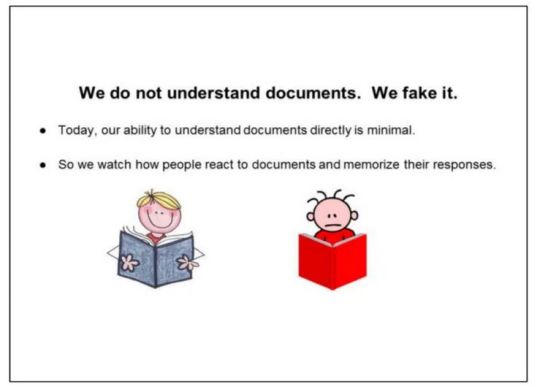
Search Engine Land about Google Search
As of 2024, it appears Google relies on user interactions on Search Engine Result Pages (SERPs) to judge content quality. Google uses a combination of automated and manual processes to assess content quality. In the initial assessment, Google checks for grammatical correctness and general coherence. The second round of assessment is based on user interactions with the content. If users engage with the content and spend time on the page, Google will likely rank it higher. However, if they are quick to leave, the algorithm takes notice of that and follows the pattern below:
Google sends traffic for about 3–4 months
After 4 months some content stops being ranked, losing about 25% of traffic
A bit later, traffic plummets to the bottom

Search Engine Land
There is a problem, though — Google’s algorithm doesn’t catch up with the massively produced AI content. A humble affiliate or advertising agency has no chance to outpace it in terms of quantity unless using AI as well. That’s why a temporary fix was put in place, which gives an additional ranking boost to user-generated content (UGC) and its respective website. Google’s core updates in August and November made Reddit and Quora more visible.
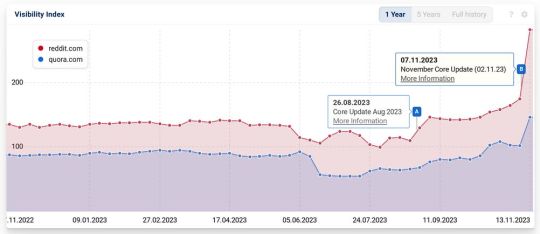
Sistrix
AI revolutionizes the market
The main goal of any entrepreneur is to make a profit. Profit maximization is essential for businesses to stay competitive. In this regard, AI is the epitome of cost-effectiveness, as it allows Netflix to save $1 billion every month on background generation. While AI accelerates content creation, it is not self-sufficient and needs the guidance of an experienced marketer.
If Google bots detect ChatGPT-generated content on your webpages, they might assume it is plagiarized and de-rank your “unoriginal” content. Google’s goal is to move beyond mimicking user searches and adopt semantic and context-based search with Google Search updates like BERT and MUM. This means bots will be able to understand information more like humans do. What does this mean for SEO and SMM professionals?
Be transparent: admit the usage of AI — there is nothing shameful in it
Be genuine: write all the content as if for the user — this is the best strategy to outwit search crawlers
Never delegate your vision: for fostering genuine connections with the customers, it’s better to rely on human-centric approach — make podcasts, webinars, and video content; then amplify that content across all the marketing channels, possibly with the help of AI
Monitor cutting-edge automation: AI can hasten high-ranking content generation, make first drafts, help targeting non-branded keywords, and even conduct website audits
Split-test: AI-generated content might be well, but there is no guarantee it will please target audience, so keep on testing no matter what for the best results
Conclusion
While AI-generated content is becoming increasingly common, its quality is often lacking. Google is aware of this trend and is taking steps to identify and de-rank low-quality AI-generated content. This means that businesses that rely solely on AI-generated content for SEO may see their rankings decline over time.
A better approach is to focus on creating high-quality, handcrafted content. This will require more effort and time, but it will also be more likely to rank well with Google and attract organic traffic to your website. In the long run, this will lead to better SEO results and more conversions.

Handcrafted content does not mean rejecting all changes. However, blindly relying on AI for content creation is not a sustainable strategy. It’s like building a house on quicksand. Instead, use AI as a tool to refine your content, but don’t let it replace your expertise. You are the master of your SEO and SMM efforts. AI is just a helpful ally, not a replacement.
Interesting headings:
Affiliate marketing case studies
Bonuses
Reviews
0 notes
Text
Google's MUM: Search Updates and SEO Implications
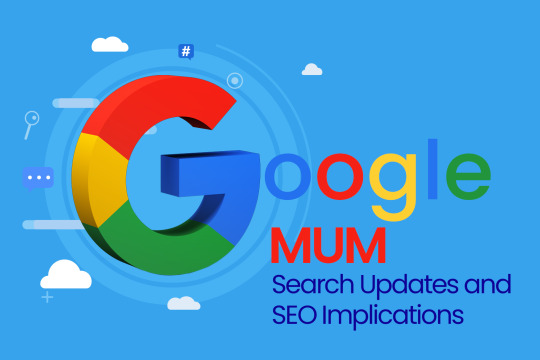
We know a single Google update has the power to change the entire picture of search results. Keeping up with Google’s updates and ranking criteria will help you not only have an efficient SEO strategy, but also provide visitors who interact with your website and content with better results for their search queries.
Google introduced a new technology in 2021 called MUM (Multitask Unified Model). The multimodal algorithm’s goal is to improve search results and overcome linguistic constraints. This algorithm can take complicated questions and give a concrete response without conducting numerous searches. By gaining access to information in various languages, images, videos, and audio, it does this.
The question of whether or when MUM would be a ranking element has received a lot of attention since the announcement.
The MUM Update’s advantages
> To compare and learn more about the searched topic, MUM will eliminate the need to conduct numerous searches. Instead of having to conduct repeated searches, users will benefit from deeper understanding using MUM.
> MUM eliminates linguistic barriers. It offers a more thorough search experience and can comprehend 75 different languages. It will leverage a user’s inquiries and compare its linguistic expertise to deliver more accurate information.
> One straightforward result can be obtained if a user wants to compare something. Thus, there is no need to conduct numerous searches. Users will have access to a plethora of knowledge across many different topics as a result of being able to quickly respond to comparison inquiries.
> Complex material becomes useful because to MUM’s usage of AI technology to improve machine learning; this should help those who prioritize user intent behind searches.
Getting Ready for MUM
SEO specialists and experts in digital marketing must keep their websites optimized for Google in order to be ready for MUM. Now is the moment to incorporate multi-language SEO into your plan, if you haven’t already. Given that you will now be competing against contributions from all around the world, having relevant, user-friendly material is more important than ever.
Creating things entails more than just using keywords. It involves a combination of creating links (not simply backlinks), employing the appropriate markup, and using the right keywords (in moderation).
Creative content that focuses on search intent rather than keyword matching will be required. Instead of focusing on a single word or phrase, think of your content to catch a variety of closely connected questions and help users to find the solution.
The rising significance of podcasts, photos, audio, and video information is one modification that might be required. You retain your relevance in accordance with the MUM algorithm when you interact with your audience through text, photos, and other forms of media.
We can assist, as the leading Digital Marketing Company in Kochi, Kerala, India, if you are concerned that your website and social media platforms are not current with the most recent Google update. We remain current with the most recent Google upgrades. For more information on how we may help you improve your search engine rankings, get in touch with us.
0 notes
Text
youtube
Watch the American Climate Leadership Awards 2024 now: https://youtu.be/bWiW4Rp8vF0?feature=shared
The American Climate Leadership Awards 2024 broadcast recording is now available on ecoAmerica's YouTube channel for viewers to be inspired by active climate leaders. Watch to find out which finalist received the $50,000 grand prize! Hosted by Vanessa Hauc and featuring Bill McKibben and Katharine Hayhoe!
#ACLA24#ACLA24Leaders#youtube#youtube video#climate leaders#climate solutions#climate action#climate and environment#climate#climate change#climate and health#climate blog#climate justice#climate news#weather and climate#environmental news#environment#environmental awareness#environment and health#environmental#environmental issues#environmental justice#environment protection#environmental health#Youtube
17K notes
·
View notes
Text
Google’s MUM: Search Updates and SEO Implications

We know a single Google update has the power to change the entire picture of search results. Keeping up with Google’s updates and ranking criteria will help you not only have an efficient SEO strategy, but also provide visitors who interact with your website and content with better results for their search queries.
Google introduced a new technology in 2021 called MUM (Multitask Unified Model). The multimodal algorithm’s goal is to improve search results and overcome linguistic constraints. This algorithm can take complicated questions and give a concrete response without conducting numerous searches. By gaining access to information in various languages, images, videos, and audio, it does this.
The question of whether or when MUM would be a ranking element has received a lot of attention since the announcement.
The MUM Update’s advantages
> To compare and learn more about the searched topic, MUM will eliminate the need to conduct numerous searches. Instead of having to conduct repeated searches, users will benefit from deeper understanding using MUM.
> MUM eliminates linguistic barriers. It offers a more thorough search experience and can comprehend 75 different languages. It will leverage a user’s inquiries and compare its linguistic expertise to deliver more accurate information.
> One straightforward result can be obtained if a user wants to compare something. Thus, there is no need to conduct numerous searches. Users will have access to a plethora of knowledge across many different topics as a result of being able to quickly respond to comparison inquiries.
> Complex material becomes useful because to MUM’s usage of AI technology to improve machine learning; this should help those who prioritize user intent behind searches.
Getting Ready for MUM
SEO specialists and experts in digital marketing must keep their websites optimized for Google in order to be ready for MUM. Now is the moment to incorporate multi-language SEO into your plan, if you haven’t already. Given that you will now be competing against contributions from all around the world, having relevant, user-friendly material is more important than ever.
Creating things entails more than just using keywords. It involves a combination of creating links (not simply backlinks), employing the appropriate markup, and using the right keywords (in moderation).
Creative content that focuses on search intent rather than keyword matching will be required. Instead of focusing on a single word or phrase, think of your content to catch a variety of closely connected questions and help users to find the solution.
The rising significance of podcasts, photos, audio, and video information is one modification that might be required. You retain your relevance in accordance with the MUM algorithm when you interact with your audience through text, photos, and other forms of media.
We can assist, as the leading Digital Marketing Company in Kochi, Kerala, India, if you are concerned that your website and social media platforms are not current with the most recent Google update. We remain current with the most recent Google upgrades. For more information on how we may help you improve your search engine rankings, get in touch with us.
0 notes
Text
How ChatGPT Model was Trained
OpenAI has developed a language model called ChatGPT that is able to respond to a wide range of topics and questions and ask clarifying questions to help debug code.
The model was trained using supervised fine-tuning, in which human AI trainers provided conversations in which they played both sides — the user and an AI assistant.
The model was also fine tuned from using reinforcement learning from human feedback, in which comparison data was collected from conversations betweenAI trainers & the chatbot & used to fine tune the model using Proximal Policy Optimization.
ChatGPT was fine tuned from a model in GPT 3.5 series & was trained on Azure AI supercomputing infrastructure.
ChatGPT Limitations?
ChatGPT has some limitations, including producing plausible but incorrect or nonsensical answers, being sensitive to changes in input phrasing, being excessively verbose and overusing certain phrases, and sometimes guessing what the user intended rather than asking clarifying questions.
Can ChatGPT replace Google?
Google has developed large AI language models (LLMs) that are as good as OpenAI’s ChatGPT. These include BERT, MUM, and LaMDA. Google uses these to make its search engine better & also help Google understand what users want when they use the search engine.
Google has created apps like AI Test Kitchen (#AITestKitchen) to show people what its chatbot technology can do. But it has limited how users will be able to interact with the chatbot.
OpenAI was also careful at first about developing its LLM technology. But then it launched ChatGPT and allowed anyone to use it which has resulted in a lot of publicity and hype for OpenAI, even though the company spends a lot of money to keep the system free.
In summary, Chatbots are still not ready to replace search engines since they still have major problems like chatbots’ bias, toxicity, and their inclination for making information up.
What’s next for Open AI?
OpenAI plans to make regular updates to the model to address these limitations. Users are encouraged to provide feedback on problematic model outputs through the user interface, as well as on false positives/negatives from the external content filter
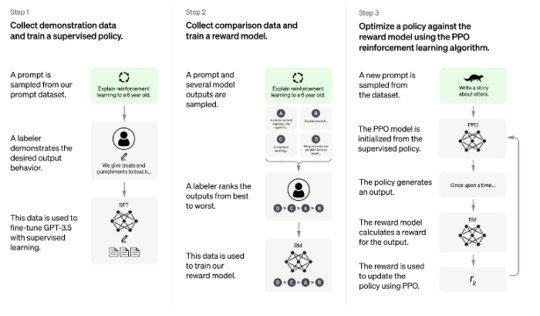
0 notes
Text
How is AI Used in Google Search?
How is AI Used in Google Search?
There are many ways that AI is being used by Google in search. There is RankBrain, MUM, BERT, and neural matching. These are all AI systems used in Google search and core updates. These systems work together to provide the best results for users. Each one of these systems uses unique algorithms to determine how to rank a page.
MUM
Google MUM, or "Micro-Unstructured Machine Translation," is a new way to use AI in search. It will allow users to ask questions in a more conversational way and provide answers in 75 different languages. With MUM, users will be able to ask questions that are more complicated or include images and videos. It will also pool results so that users can access information in a more comprehensive way.
Google MUM will improve search results in many ways, including by unlocking information from images, documents, videos, and audio. It can identify missing words, contextualize the information, and link it with other sources to provide the best results based on the user's query. It will also be able to interpret a wide range of languages and provide more relevant results.
While BERT used NLP to understand search intent, Google MUM is more sophisticated. It can understand the subtleties in speech and understand nuances in linguistics. As a result, it can help marketers target their audiences with more relevant content. With the right content, users will be more likely to see your site in the search results and buy products you might be interested in.
MUM also understands multimodal content and can connect images and text. For example, if you are looking for boots, MUM will help you find the best pair of boots that match your style and preferences. It can also recommend fitness programs and fitness equipment that fit your specific needs.
BERT
One of the biggest improvements to Google's search algorithm was the introduction of Bidirectional Encoder Representations (BERT). This technique forces search engines to understand the context of words in search queries. It helps Google understand more complex queries and longer, conversational searches. It is now deployed in every English search and is also being tested in languages other than English.
In the past, Google didn't understand prepositions or the word "to," which change the intent of a search query. But with BERT, the algorithm understands the context of the phrase and tries to connect the searcher to relevant content. This leads to more accurate results.
Another advancement that AI is making in Google search is the ability to index individual passages of webpages. This feature has the potential to improve 7% of searches. Additionally, Google is bringing a Data Commons-based search to its search results. This project combines data from publicly available datasets and mapped common entities to give users a more relevant search experience.
Google processes more than six thousand search queries a second, and around two trillion searches per year. These volumes are too high for traditional software to handle. In addition, human workers can't accurately predict patterns in such massive volumes of data. Therefore, artificial intelligence is essential to serve users with relevant results.
RankBrain
In order to make the most of the benefits of RankBrain AI in Google search, you must ensure that your content focuses on real people. This is especially important in the case of long-tail searches, where a more descriptive piece of content has a better chance of appearing in the SERP. You can also optimise your content by deep linking internal and external relevant pages. Deep linking helps Google's Brain understand the relationship between different elements on your site. Finally, you must make sure that your content leads to a conversion.
The AI system that powers Google's search results uses machine learning to interpret the signals that a user provides. This means that the algorithm can learn from the user's behavior, and can refine their query. It then orders search results based on the signals that it identifies. While it can't read minds, it can interpret signals such as how long someone spent on a page, how much they spent clicking the back button, and how many times they searched for a specific term.
RankBrain works by using mathematical and advanced semantic processes to understand the relationship between words and phrases. The algorithm aims to find words and phrases that are most relevant to what the user is searching for. As it is not pre-programmed, it tries to understand what the user truly wants and eliminates irrelevant results.
Read the full article
0 notes
Text
Google’s 2022 AI Update: What It Is, How It Works, and How It Can Affect Your SEO
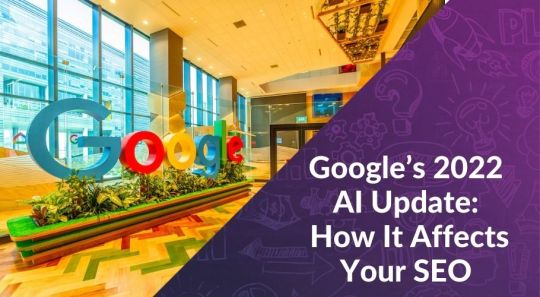
If there’s one thing Google’s known for, it’s the notoriously obtuse and frequent algorithm updates applied to its search engine.
Given catchy names like Big Daddy, Panda, Penguin, and Hummingbird, these updates can have a significant effect on the way search engine optimization is done, and a devastating effect on website rankings.
As a result, what were once considered best practices can quickly become obsolete not long after Google announces its next update, causing marketers to have to scramble to understand how to navigate these changes, often to no avail.
To make things worse, in an effort to protect user experience, and prevent people from exploiting its algorithm, Google tends to be quite vague about what these updates truly mean, and how they actually affect SEO.
With that said, even though it can be annoyingly tough to understand the effect of these updates, the best thing we can do is try to learn as much about them as possible.
So, if you’ve heard about Google’s latest AI update, and you’re wondering what it is and how these algorithm changes affect search rankings, then this article is for you.
Keep reading to find out what this latest update is, how it works, and how it might affect your website’s ranking.
MUM: Google’s Latest AI Update
The latest algorithm update from Google is called Multitask Unified Model, or MUM for short, which is pretty ironic considering how tight-lipped the search engine giant tends to be.
In a nutshell, this update is built to improve user experience by providing more relevant search results through a better understanding of the feelings and intent of users.
The idea is to prevent people from having to make multiple search queries when trying to get answers to complex questions, which makes sense, given that Google is all about making things more convenient for users.
In an article from Google’s Vice President, Search, Pandu Nayak, he says “we find that people issue eight queries on average for complex tasks”.
The article goes on to say that ideally, Google wants its algorithm to be able to answer your questions in the way a subject matter expert would, where you could ask a single question and “get a thoughtful answer that takes into account the nuances of your task at hand and guides you through the many things to consider.”
In the video below, Prabhakar Raghavan, a Senior Vice President at Google, explains how this update ties into Google’s mission “to make information accessible and useful.”
https://www.youtube.com/watch?v=e2ZyYJ_7eQg
READ: How To E-A-T Your Way to the Content Google Like

Google can be incredibly picky when it comes to content.
It tends to favour content that offers value and relevance for users, and one of the ways it makes those distinctions is by considering the expertise, authority, and trustworthiness of content creators.
This article discusses why these aspects are so important, how they affect SEO, and how to go about improving your E-A-T rating.
Read more here.
Using the Text-To-Text Transfer Transformer, otherwise known as T5, Google's latest AI update gives its algorithm a much greater understanding of language in general, which allows it to better understand what people are searching for, and therefore offer more relevant and helpful search results.
T5, which is a machine learning technique for natural language processing (NLP), is 1,000 times more powerful than BERT, Google’s last major NLP update, which helped its algorithm to better understand the full context of words by considering the words that come before and after them.
If you want to learn more about T5, an article from Google’s AI Blog goes into all the technical details, but I can just barely begin to comprehend this stuff, so good luck.
Now, what’s different about MUM is that besides being able to understand language, it can also generate it.
It’s also trained in 75 different languages, and has the capability to bring relevant information to you, even if it’s not written in the same language you used to write your search query.
It can handle many different tasks at the same time, and it’s multimodal, so it can understand information in the form of text, but also through images, as well.
In addition, Google plans to expand its ability to understand information through even more modalities, including things like video and audio.
In any case, MUM’s capabilities have yet to be fully implemented, but Google vows to continue using its new “AI milestone” to improve its search engine in the months and years ahead.
That being said, one day, you might be able to take a photo of your favourite wok and ask, “Is this the best pan for cooking pad thai?”, and Google will be able to provide highly relevant results, using just a single image and a few words.

How Will MUM Affect Search Rankings?
So, how will these algorithm changes affect search rankings?
Well, given the multitude of possibilities posed by this new update, it’s certainly safe to say that MUM is going to have a significant effect on the way websites are ranked on Google.
But considering the fact that MUM’s functionality has yet to be fully realized, it’s pretty tough to say exactly how it’s going to affect search rankings and the world of SEO in general.
And Google’s not making this any easier to understand either.
As pointed out in an article from Search Engine Journal, when Google’s Search Advocate, John Mueller, was asked what percentage of searches in the U.S. would be impacted by MUM, he gave a characteristically vague answer.
“I have no idea,” he said, explaining that MUM is “something that can be applied to lots of different parts of search,” and “It’s not so much that you would isolate it to just ranking.”
If you want to learn more, the video below shows the full conversation with Mueller during one of Google’s SEO office-hours hangouts, where SEO specialists can ask all their search-related questions.
https://www.youtube.com/watch?v=fj6iWbCjrrE&t=133s
So, while the effect of Google's latest AI update will probably never be quantified, what we do know is that, at least when it comes to search rankings, this update is essentially more of the same.
As always, Google’s main goal is to provide the best possible experience for users, and this update maintains that same focus.
Ultimately, its purpose is to provide even more relevant results, and therefore I believe the main effect of this update on search rankings will be to further increase the importance of content quality and user intent.
The end result will be that content that doesn’t provide solid value, or doesn’t put an emphasis on the intent of users will continue to be pushed further and further down the search rankings, even more than it already has been by previous algorithm updates.
That being said, the best thing you can do to protect your website ranking from the effects of this latest update is to make user experience your primary focus.
Does the thought of trying to keep up with the ever-changing world of SEO make you uneasy? Would you rather trust your website ranking to a seasoned team of SEO experts?
Contact us today to find out how we can SEO-optimize your website to make it more discoverable for your ideal customers.
To Your Business Success,
Susan Friesen
P.S. If you liked what you read (and heard) here, you will want to sign up for our newsletter where you'll get notified every week of our blog posts, announcements and business-building strategies. Click here to also receive our free website guide: www.UltimateWebsiteGuide.ca
0 notes
Text
Is Personalized Multimedia Search the Biggest SEO Trend of This Year?
One of the most important facets of search engine optimization (SEO) is that it is constantly evolving — and we have seen search engines adapt to the way users search online.
Not too long ago, Google’s primary focus was on the desktop. However, as smartphones became more ubiquitous, the search engine giant began prioritizing mobile experiences through mobile-first indexing. Its implications are simple: whether you want to run a Long Island search engine marketing campaign or optimize your site for search, you must now provide an excellent mobile experience to users.
Additionally, we have witnessed the emergence of voice search, which has prompted online business owners to evaluate how they can improve their websites’ ability to respond to user intent on mobile devices. One trend we expect to see more of in 2022 is search engines becoming more adept at synthesizing multimedia and multilingual information. This means that online users will be able to photograph things they encounter in the real world and use those photos to find products they want to buy online. This will enable the physical and virtual worlds to integrate seamlessly, creating an enhanced omnichannel experience.
Now, visual search is a technology that has been around for some years — and we have seen some big players invest in it, like IKEA, Pinterest, and Amazon. In 2019, Amazon announced an AI-powered feature called Style Snap, which enables users to upload photos or screenshots of items using the Amazon app. Amazon will then provide recommendations for similar items based on the photo.
This should be on your radar in 2022 since Google is entering the fray with its multitask unified model (MUM). This novel technique will significantly enhance how search engines perceive user intent. In terms of visual content, it will seek to enhance Google Lens’ capabilities. In the future, users will be able to photograph a pattern on a shirt and type in a query such as “find me a pair of trousers with this pattern.” Google Lens will be smart enough to understand the query and return relevant product results from several e-commerce stores to satisfy users’ intent.
Now, from an e-commerce viewpoint, you can see how this new capability can enable new options for product discovery. It is an intriguing avenue that your business should monitor and capitalize on this year.
In terms of how to optimize for it, everything is mainly speculative at the moment. First, you can train Google to recognize your items by adding structured data to pictures. If you want your business to be visible for image searches related to a certain product, keep in mind that the e-commerce stores that succeed in this field will have the most variety and high-quality photographs for that product.
We recommend that you provide a combination of lifestyle and white background photographs in several various composition styles — this will give you a more robust basis for driving traffic through this new medium. For e-commerce managers, work with an SEO firm in New York City to test different image compositions to see which works the best in this space.
0 notes
Text
How Google uses artificial intelligence In Google Search
From RankBrain, Neural Matching, BERT and MUM – here is how Google uses AI for understanding language for query, content and ranking purposes.
Please visit Search Engine Land for the full article.
Digital marketing agency in darbhanga Digital marketing agency in patna Digital marketing agency in Muzaffarpur Digital marketing agency in bangalore
0 notes
Text
The Top Tech SEO Strategies for 2022 and Beyond
Last year was an incredible year for Core Updates, and for changes to how SEOs improve page quality for users. Moving forward, we can expect to see increased diversification of SERPs, led by developments in Google’s algorithms, and new features from tools like Google Lens. These developments will change how we manage our SEO now and in the future.
Multimedia first
Why should you consider a multimedia-first SEO strategy?
MUM is the latest in Google’s suite of super-powerful algorithms, which help them to understand information in new and different ways. It runs alongside BERT, but it's actually much more powerful than BERT.
MUM stands for “multitask unified model”, and not only does it process natural language, but it does so in over 75 languages — and counting. It's also able to process text and images with a similar quality, and is increasing its ability to process video and audio in the near future. This means we’re likely to see the impact of this in the SERPs, specifically what they look like, which is also likely to shape some of the targeted algorithm updates in the future.
This shift in focus is a natural evolution of a mobile-first digital experience that allows users to engage with content dynamically using a mix of inputs, outputs, and tools, often simultaneously. Google’s push towards better understanding — and towards ranking media like image and video — will require SEOs to look at multimedia content with fresh eyes.
Which short-term multimedia optimizations should you prioritize in 2022?
Visual recognition for Google Lens
Google has invested significantly in image recognition solutions for almost 10 years, but they have recently picked up the pace and scale of its integration into everyday search.

As a result, improvements to and new uses for Google Lens have been front and center at flagship events like Google I/O and SearchOn during the last 12 months, while their future plans to move into health depend significantly on honing their visual search abilities.
In 2021, they added Google Lens directly into the search widget for Pixel, Android phones, and onto Chrome’s mobile search bar. Last year’s Google Lens updates included the ability to translate text in over 100 languages via AR and carry out targeted visual searches of screenshots. Add to this list of features their upcoming rollout of a MUM-enabled ability to “Add Questions” to Lens searches, and you can see that change is afoot.
How does Google Lens impact image SEO?
Standard image optimization elements like alt-text, schema markup, file names, image titles, and file sizes will continue to be important and relevant in regards to how search engines understand your image. Building upon this, though, elements like composition will also come to the fore. This means that SEOs might need to have more strategic conversations about what images look like, as well as how they’re rendered on a site.
This is because, while AI-driven image processing tools like Google Cloud’s Vision AI and Google Lens are developing rapidly, images that have clear composition will be better understood for visual search than images that are cluttered, complex, or partially visible.
Simply put, cleaner images mean that your content is surfaced with more relevant search results and business outcomes.
SEO value of image composition
Need to illustrate the point to stakeholders? Released in 2015, Vision AI’s image recognition tech underpins many of the functions of Google Lens, and their free demo tool can be used to demonstrate how images are interpreted at a high level. Pair this with real-time Google Lens results to illustrate where you should be concentrating your image optimization efforts as MUM matures.

Google's Vision AI API testing tool.
Case in point, in the diagram below, you can see two photos of the same enamel teapot as analyzed with Google Cloud’s Vision AI API testing tool and then with Google Lens.
In the image where you can’t see the handle and spout at the same time, the Vision AI interprets the photo as a Tableware object with 76% certainty and adds Kettle as the most relevant searchable label with 74% certainty. Conversely, the image with the teapot in the profile is understood as a Teapot with 94% certainty and given a Teapot label with 89% certainty.

How composition impacts Vision AI interpretation of images.
When we click through to the SERPs for kettle and teapot, we can see a clear difference in results. It is also clear that the latter is a much closer match to the actual object, thus more likely to satisfy customer needs, resulting in more click-throughs and driving better SEO for the site overall.
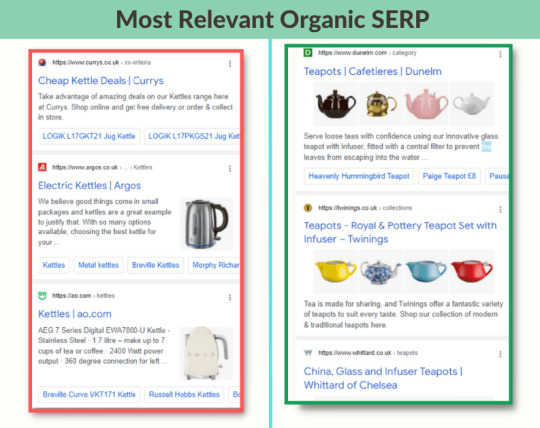
Left shows results for ‘Kettle’. Right shows results for ‘Teapot’
When we search the same images directly in Google Lens, the overall results are better: this time both are showing enamel teapots. But again, we see that the side profile photo is delivering near-exact matches to my IRL teapot. Thus, better photo composition equates to better search optimization.
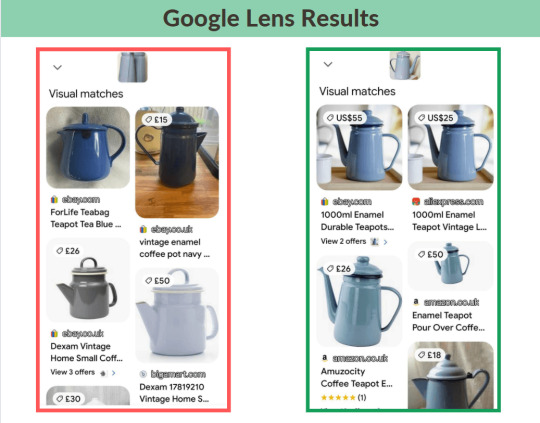
Better images give more relevant in Google Lens.
In practice, this means that while there may be a desire to fill a site with stylish lifestyle or Instagram-ready images, for SEO purposes, it is important to prioritize clean, — dare I say “boring” — images, particularly for transactional pages like product listings.
While this methodology is not necessarily new, the accessibility and integration of “search what you see” tools in the daily search experience will make image composition considerations for SEO a priority moving forward.
AI is allowing Google to make comparable strides with video and audio analysis, meaning investment in the knowledge of audio quality and video aesthetics could pay SEO dividends in the future.
Security for speed
Security and speed are both established ranking factors. During the great Core Web Vitals push of 2021, many came to understand that the two elements are closely linked. On an individual account level, I've seen server security optimization improve page performance for multiple clients. On a larger scale, when hosting platform Wix tripled their year-over-year CWV performance, enhancements like universal HTTP/2 to improve SSL times were critical to the task.
In the coming year, we will see Google prioritize security in its products and search services. Chrome promises the rollout of increased security and privacy tools, with updates that will include security features for <iframes> and cross-site navigation that add more checks as users transfer between links and use certain features.
This could give sites with top-tier security a competitive advantage for speed, page experience, and conversions in the coming year. And as the desktop page experience ranking update arrives in February 2022, the impact may be seen across many more domains.
Add to this trend the enthusiastic adoption of high-speed HTTP/3 by big tech players like Facebook and Google, and you can see that legacy tech will struggle to keep pace with user and bot expectations.
The use of HTTP/3, the latest HTTP protocol, has seen a fivefold increase across the web in the last year and is now live on about 25% of domains. Though this protocol is active on Cloudflare and many other top cloud providers, it is not yet standard. If you want to make the most of the benefits here, you may need to manually enable the update for your main server and/or CDN. And if you’re considering a new CDN or server partner in the coming year, this should be a deciding factor.
SEO specialisms for Google channel diversity
Google continues to reduce friction as users move between their dedicated channels and apps. In the process, they’re creating a more dynamic and niche SERP that requires SEO specialism to gain traction.
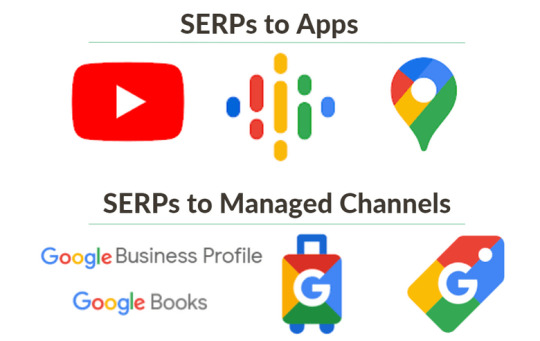
Click-throughs for some SERP results go to Google managed channels and apps.
From a user experience, this makes for rich mobile-friendly SERPs, which take users directly into high-performance apps like Google Maps and dedicated channels like Google Travel. Furthermore, it affords Google the opportunity to access and combine the information users need in a highly contextualized manner. Since Google-managed properties give them control over many informational feeds at once, enhancing and connecting existing channels will be essential to their aims to serve ever more nuanced search results.
While this has long been the preserve of transactional verticals like shopping and hotels, Google’s commitment to multi-modality means this is likely to become more prevalent amongst queries at the top of the funnel as well. This means SEO efforts must also be made to optimize profiles and performance within each of the most relevant channels in order to maximize visibility in the SERPs. Due to the rate of change for each channel, SEO generalism is increasingly less likely to build a critical mass for impact. Instead, coordinated teams for SEO specialisms are likely to see the most gains.
If we look at Local Inventory Ads (LIA) for instance, we can see optimizations for multiple channels converge to make a complex, high-value search feature. Introduced last year, this free and paid Google Shopping feature allows users to find products in stock at shops near their location. Google uses data and content from websites, Google Business Profiles, Maps, and Merchant Center to surface this information when users need it. Ongoing optimization for LIA requires expertise in each of these channels, running in tandem with a collection of SEO skill sets.

All of this is to say that assembling a well-rounded SEO team will be essential to top performance as multimodal search evolves. Consider nurturing in-house channel champions and/or engaging external product experts via an agency or freelance support, and coordinate to achieve business goals in search.
Borderless international SEO
In the coming year, three factors will become significant drivers for international SEO: the rise of borderless e-commerce, the maturity of AI translation tools, and the rollout of MUM.
Borderless e-commerce
Digital acceleration has changed our digital experience significantly.
The relevance of a business’s physical location, currency, and time zone is shifting, and the barriers to entry for brands to go global are being significantly reduced. Brick-and-mortar businesses still have a significant impact on local SEO and local pack SERPs, but customers are increasingly more willing (and more often, expecting) to buy from retailers outside their country. Research shows that tentative markets, where around 40% of consumers were willing to purchase from overseas sellers in 2016, had shifted to 55% willingness in 2021.
Shopify launched Shopify Markets at the start of Q4 2021, full of confidence in this global retail trend and its potential for sellers, meaning that competition here is likely to heat up in the coming months.
As SEOs, our task is to meet customers where they are, and this change in customer expectations brings opportunities for business growth. To get started here, consider tried-and-tested international SEO tactics alongside low-cost, low-friction market entry channels like free Google Merchant Listings.
If your international growth includes selling on top international marketplaces like Amazon, Wish, AliExpress, or eBay, consider optimizing your landing pages and on-site e-commerce E-A-T to build trust with new customers. Finally, think mobile-first for shoppers in Asia and other emerging markets.
In summary
All in all, I’m optimistic. As MUM matures we should see more varied content types emerge from around the web. Improvements to speed and security are a win for everyone. More layered SERP features help to demonstrate the importance of SEO. And building a borderless customer base helps to make brands more resilient in a changeable marketplace. Some of the changes we are likely to see are substantial, but they should move SEO in a positive direction.
0 notes
Text
The Top Tech SEO Strategies for 2022 and Beyond
Last year was an incredible year for Core Updates, and for changes to how SEOs improve page quality for users. Moving forward, we can expect to see increased diversification of SERPs, led by developments in Google’s algorithms, and new features from tools like Google Lens. These developments will change how we manage our SEO now and in the future.
Multimedia first
Why should you consider a multimedia-first SEO strategy?
MUM is the latest in Google’s suite of super-powerful algorithms, which help them to understand information in new and different ways. It runs alongside BERT, but it's actually much more powerful than BERT.
MUM stands for “multitask unified model”, and not only does it process natural language, but it does so in over 75 languages — and counting. It's also able to process text and images with a similar quality, and is increasing its ability to process video and audio in the near future. This means we’re likely to see the impact of this in the SERPs, specifically what they look like, which is also likely to shape some of the targeted algorithm updates in the future.
This shift in focus is a natural evolution of a mobile-first digital experience that allows users to engage with content dynamically using a mix of inputs, outputs, and tools, often simultaneously. Google’s push towards better understanding — and towards ranking media like image and video — will require SEOs to look at multimedia content with fresh eyes.
Which short-term multimedia optimizations should you prioritize in 2022?
Visual recognition for Google Lens
Google has invested significantly in image recognition solutions for almost 10 years, but they have recently picked up the pace and scale of its integration into everyday search.

As a result, improvements to and new uses for Google Lens have been front and center at flagship events like Google I/O and SearchOn during the last 12 months, while their future plans to move into health depend significantly on honing their visual search abilities.
In 2021, they added Google Lens directly into the search widget for Pixel, Android phones, and onto Chrome’s mobile search bar. Last year’s Google Lens updates included the ability to translate text in over 100 languages via AR and carry out targeted visual searches of screenshots. Add to this list of features their upcoming rollout of a MUM-enabled ability to “Add Questions” to Lens searches, and you can see that change is afoot.
How does Google Lens impact image SEO?
Standard image optimization elements like alt-text, schema markup, file names, image titles, and file sizes will continue to be important and relevant in regards to how search engines understand your image. Building upon this, though, elements like composition will also come to the fore. This means that SEOs might need to have more strategic conversations about what images look like, as well as how they’re rendered on a site.
This is because, while AI-driven image processing tools like Google Cloud’s Vision AI and Google Lens are developing rapidly, images that have clear composition will be better understood for visual search than images that are cluttered, complex, or partially visible.
Simply put, cleaner images mean that your content is surfaced with more relevant search results and business outcomes.
SEO value of image composition
Need to illustrate the point to stakeholders? Released in 2015, Vision AI’s image recognition tech underpins many of the functions of Google Lens, and their free demo tool can be used to demonstrate how images are interpreted at a high level. Pair this with real-time Google Lens results to illustrate where you should be concentrating your image optimization efforts as MUM matures.

Google's Vision AI API testing tool.
Case in point, in the diagram below, you can see two photos of the same enamel teapot as analyzed with Google Cloud’s Vision AI API testing tool and then with Google Lens.
In the image where you can’t see the handle and spout at the same time, the Vision AI interprets the photo as a Tableware object with 76% certainty and adds Kettle as the most relevant searchable label with 74% certainty. Conversely, the image with the teapot in the profile is understood as a Teapot with 94% certainty and given a Teapot label with 89% certainty.
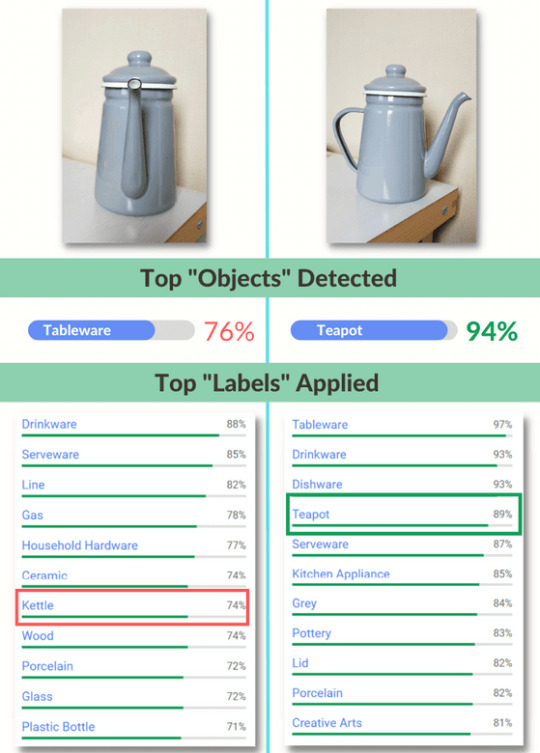
How composition impacts Vision AI interpretation of images.
When we click through to the SERPs for kettle and teapot, we can see a clear difference in results. It is also clear that the latter is a much closer match to the actual object, thus more likely to satisfy customer needs, resulting in more click-throughs and driving better SEO for the site overall.
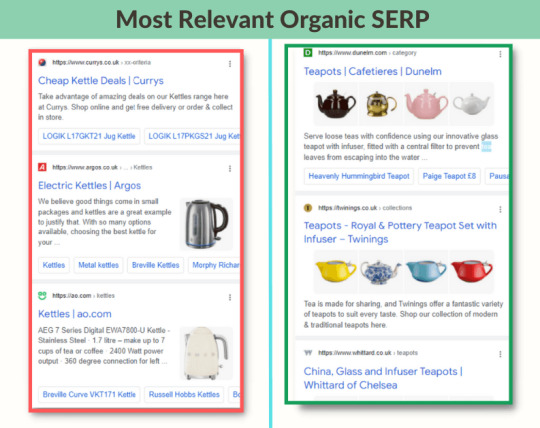
Left shows results for ‘Kettle’. Right shows results for ‘Teapot’
When we search the same images directly in Google Lens, the overall results are better: this time both are showing enamel teapots. But again, we see that the side profile photo is delivering near-exact matches to my IRL teapot. Thus, better photo composition equates to better search optimization.
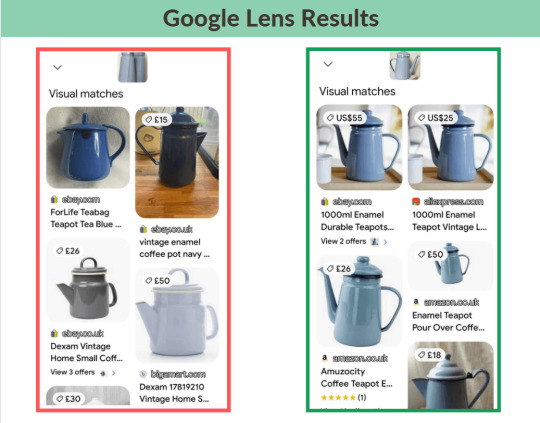
Better images give more relevant in Google Lens.
In practice, this means that while there may be a desire to fill a site with stylish lifestyle or Instagram-ready images, for SEO purposes, it is important to prioritize clean, — dare I say “boring” — images, particularly for transactional pages like product listings.
While this methodology is not necessarily new, the accessibility and integration of “search what you see” tools in the daily search experience will make image composition considerations for SEO a priority moving forward.
AI is allowing Google to make comparable strides with video and audio analysis, meaning investment in the knowledge of audio quality and video aesthetics could pay SEO dividends in the future.
Security for speed
Security and speed are both established ranking factors. During the great Core Web Vitals push of 2021, many came to understand that the two elements are closely linked. On an individual account level, I've seen server security optimization improve page performance for multiple clients. On a larger scale, when hosting platform Wix tripled their year-over-year CWV performance, enhancements like universal HTTP/2 to improve SSL times were critical to the task.
In the coming year, we will see Google prioritize security in its products and search services. Chrome promises the rollout of increased security and privacy tools, with updates that will include security features for <iframes> and cross-site navigation that add more checks as users transfer between links and use certain features.
This could give sites with top-tier security a competitive advantage for speed, page experience, and conversions in the coming year. And as the desktop page experience ranking update arrives in February 2022, the impact may be seen across many more domains.
Add to this trend the enthusiastic adoption of high-speed HTTP/3 by big tech players like Facebook and Google, and you can see that legacy tech will struggle to keep pace with user and bot expectations.
The use of HTTP/3, the latest HTTP protocol, has seen a fivefold increase across the web in the last year and is now live on about 25% of domains. Though this protocol is active on Cloudflare and many other top cloud providers, it is not yet standard. If you want to make the most of the benefits here, you may need to manually enable the update for your main server and/or CDN. And if you’re considering a new CDN or server partner in the coming year, this should be a deciding factor.
SEO specialisms for Google channel diversity
Google continues to reduce friction as users move between their dedicated channels and apps. In the process, they’re creating a more dynamic and niche SERP that requires SEO specialism to gain traction.

Click-throughs for some SERP results go to Google managed channels and apps.
From a user experience, this makes for rich mobile-friendly SERPs, which take users directly into high-performance apps like Google Maps and dedicated channels like Google Travel. Furthermore, it affords Google the opportunity to access and combine the information users need in a highly contextualized manner. Since Google-managed properties give them control over many informational feeds at once, enhancing and connecting existing channels will be essential to their aims to serve ever more nuanced search results.
While this has long been the preserve of transactional verticals like shopping and hotels, Google’s commitment to multi-modality means this is likely to become more prevalent amongst queries at the top of the funnel as well. This means SEO efforts must also be made to optimize profiles and performance within each of the most relevant channels in order to maximize visibility in the SERPs. Due to the rate of change for each channel, SEO generalism is increasingly less likely to build a critical mass for impact. Instead, coordinated teams for SEO specialisms are likely to see the most gains.
If we look at Local Inventory Ads (LIA) for instance, we can see optimizations for multiple channels converge to make a complex, high-value search feature. Introduced last year, this free and paid Google Shopping feature allows users to find products in stock at shops near their location. Google uses data and content from websites, Google Business Profiles, Maps, and Merchant Center to surface this information when users need it. Ongoing optimization for LIA requires expertise in each of these channels, running in tandem with a collection of SEO skill sets.
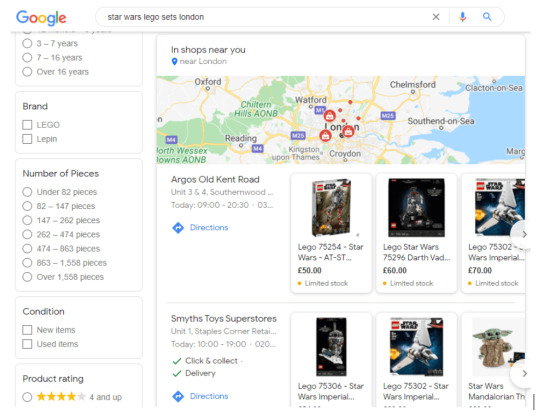
All of this is to say that assembling a well-rounded SEO team will be essential to top performance as multimodal search evolves. Consider nurturing in-house channel champions and/or engaging external product experts via an agency or freelance support, and coordinate to achieve business goals in search.
Borderless international SEO
In the coming year, three factors will become significant drivers for international SEO: the rise of borderless e-commerce, the maturity of AI translation tools, and the rollout of MUM.
Borderless e-commerce
Digital acceleration has changed our digital experience significantly.
The relevance of a business’s physical location, currency, and time zone is shifting, and the barriers to entry for brands to go global are being significantly reduced. Brick-and-mortar businesses still have a significant impact on local SEO and local pack SERPs, but customers are increasingly more willing (and more often, expecting) to buy from retailers outside their country. Research shows that tentative markets, where around 40% of consumers were willing to purchase from overseas sellers in 2016, had shifted to 55% willingness in 2021.
Shopify launched Shopify Markets at the start of Q4 2021, full of confidence in this global retail trend and its potential for sellers, meaning that competition here is likely to heat up in the coming months.
As SEOs, our task is to meet customers where they are, and this change in customer expectations brings opportunities for business growth. To get started here, consider tried-and-tested international SEO tactics alongside low-cost, low-friction market entry channels like free Google Merchant Listings.
If your international growth includes selling on top international marketplaces like Amazon, Wish, AliExpress, or eBay, consider optimizing your landing pages and on-site e-commerce E-A-T to build trust with new customers. Finally, think mobile-first for shoppers in Asia and other emerging markets.
In summary
All in all, I’m optimistic. As MUM matures we should see more varied content types emerge from around the web. Improvements to speed and security are a win for everyone. More layered SERP features help to demonstrate the importance of SEO. And building a borderless customer base helps to make brands more resilient in a changeable marketplace. Some of the changes we are likely to see are substantial, but they should move SEO in a positive direction.
0 notes
Text
The Top Tech SEO Strategies for 2022 and Beyond
Last year was an incredible year for Core Updates, and for changes to how SEOs improve page quality for users. Moving forward, we can expect to see increased diversification of SERPs, led by developments in Google’s algorithms, and new features from tools like Google Lens. These developments will change how we manage our SEO now and in the future.
Multimedia first
Why should you consider a multimedia-first SEO strategy?
MUM is the latest in Google’s suite of super-powerful algorithms, which help them to understand information in new and different ways. It runs alongside BERT, but it's actually much more powerful than BERT.
MUM stands for “multitask unified model”, and not only does it process natural language, but it does so in over 75 languages — and counting. It's also able to process text and images with a similar quality, and is increasing its ability to process video and audio in the near future. This means we’re likely to see the impact of this in the SERPs, specifically what they look like, which is also likely to shape some of the targeted algorithm updates in the future.
This shift in focus is a natural evolution of a mobile-first digital experience that allows users to engage with content dynamically using a mix of inputs, outputs, and tools, often simultaneously. Google’s push towards better understanding — and towards ranking media like image and video — will require SEOs to look at multimedia content with fresh eyes.
Which short-term multimedia optimizations should you prioritize in 2022?
Visual recognition for Google Lens
Google has invested significantly in image recognition solutions for almost 10 years, but they have recently picked up the pace and scale of its integration into everyday search.

As a result, improvements to and new uses for Google Lens have been front and center at flagship events like Google I/O and SearchOn during the last 12 months, while their future plans to move into health depend significantly on honing their visual search abilities.
In 2021, they added Google Lens directly into the search widget for Pixel, Android phones, and onto Chrome’s mobile search bar. Last year’s Google Lens updates included the ability to translate text in over 100 languages via AR and carry out targeted visual searches of screenshots. Add to this list of features their upcoming rollout of a MUM-enabled ability to “Add Questions” to Lens searches, and you can see that change is afoot.
How does Google Lens impact image SEO?
Standard image optimization elements like alt-text, schema markup, file names, image titles, and file sizes will continue to be important and relevant in regards to how search engines understand your image. Building upon this, though, elements like composition will also come to the fore. This means that SEOs might need to have more strategic conversations about what images look like, as well as how they’re rendered on a site.
This is because, while AI-driven image processing tools like Google Cloud’s Vision AI and Google Lens are developing rapidly, images that have clear composition will be better understood for visual search than images that are cluttered, complex, or partially visible.
Simply put, cleaner images mean that your content is surfaced with more relevant search results and business outcomes.
SEO value of image composition
Need to illustrate the point to stakeholders? Released in 2015, Vision AI’s image recognition tech underpins many of the functions of Google Lens, and their free demo tool can be used to demonstrate how images are interpreted at a high level. Pair this with real-time Google Lens results to illustrate where you should be concentrating your image optimization efforts as MUM matures.

Google's Vision AI API testing tool.
Case in point, in the diagram below, you can see two photos of the same enamel teapot as analyzed with Google Cloud’s Vision AI API testing tool and then with Google Lens.
In the image where you can’t see the handle and spout at the same time, the Vision AI interprets the photo as a Tableware object with 76% certainty and adds Kettle as the most relevant searchable label with 74% certainty. Conversely, the image with the teapot in the profile is understood as a Teapot with 94% certainty and given a Teapot label with 89% certainty.
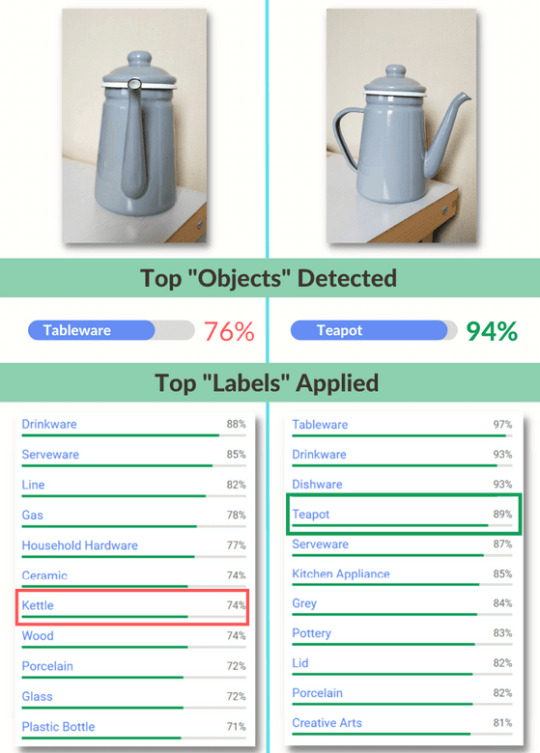
How composition impacts Vision AI interpretation of images.
When we click through to the SERPs for kettle and teapot, we can see a clear difference in results. It is also clear that the latter is a much closer match to the actual object, thus more likely to satisfy customer needs, resulting in more click-throughs and driving better SEO for the site overall.

Left shows results for ‘Kettle’. Right shows results for ‘Teapot’
When we search the same images directly in Google Lens, the overall results are better: this time both are showing enamel teapots. But again, we see that the side profile photo is delivering near-exact matches to my IRL teapot. Thus, better photo composition equates to better search optimization.
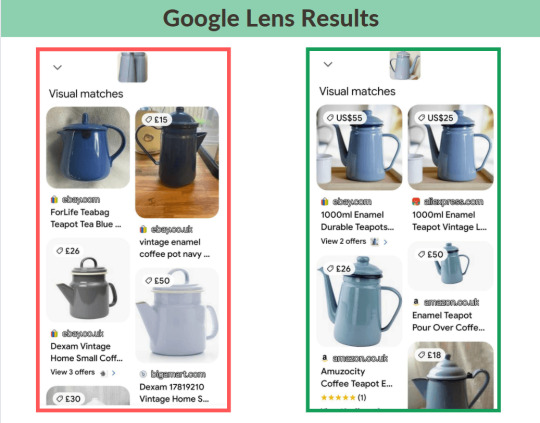
Better images give more relevant in Google Lens.
In practice, this means that while there may be a desire to fill a site with stylish lifestyle or Instagram-ready images, for SEO purposes, it is important to prioritize clean, — dare I say “boring” — images, particularly for transactional pages like product listings.
While this methodology is not necessarily new, the accessibility and integration of “search what you see” tools in the daily search experience will make image composition considerations for SEO a priority moving forward.
AI is allowing Google to make comparable strides with video and audio analysis, meaning investment in the knowledge of audio quality and video aesthetics could pay SEO dividends in the future.
Security for speed
Security and speed are both established ranking factors. During the great Core Web Vitals push of 2021, many came to understand that the two elements are closely linked. On an individual account level, I've seen server security optimization improve page performance for multiple clients. On a larger scale, when hosting platform Wix tripled their year-over-year CWV performance, enhancements like universal HTTP/2 to improve SSL times were critical to the task.
In the coming year, we will see Google prioritize security in its products and search services. Chrome promises the rollout of increased security and privacy tools, with updates that will include security features for <iframes> and cross-site navigation that add more checks as users transfer between links and use certain features.
This could give sites with top-tier security a competitive advantage for speed, page experience, and conversions in the coming year. And as the desktop page experience ranking update arrives in February 2022, the impact may be seen across many more domains.
Add to this trend the enthusiastic adoption of high-speed HTTP/3 by big tech players like Facebook and Google, and you can see that legacy tech will struggle to keep pace with user and bot expectations.
The use of HTTP/3, the latest HTTP protocol, has seen a fivefold increase across the web in the last year and is now live on about 25% of domains. Though this protocol is active on Cloudflare and many other top cloud providers, it is not yet standard. If you want to make the most of the benefits here, you may need to manually enable the update for your main server and/or CDN. And if you’re considering a new CDN or server partner in the coming year, this should be a deciding factor.
SEO specialisms for Google channel diversity
Google continues to reduce friction as users move between their dedicated channels and apps. In the process, they’re creating a more dynamic and niche SERP that requires SEO specialism to gain traction.
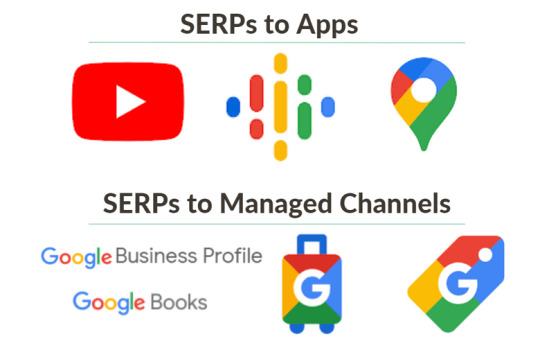
Click-throughs for some SERP results go to Google managed channels and apps.
From a user experience, this makes for rich mobile-friendly SERPs, which take users directly into high-performance apps like Google Maps and dedicated channels like Google Travel. Furthermore, it affords Google the opportunity to access and combine the information users need in a highly contextualized manner. Since Google-managed properties give them control over many informational feeds at once, enhancing and connecting existing channels will be essential to their aims to serve ever more nuanced search results.
While this has long been the preserve of transactional verticals like shopping and hotels, Google’s commitment to multi-modality means this is likely to become more prevalent amongst queries at the top of the funnel as well. This means SEO efforts must also be made to optimize profiles and performance within each of the most relevant channels in order to maximize visibility in the SERPs. Due to the rate of change for each channel, SEO generalism is increasingly less likely to build a critical mass for impact. Instead, coordinated teams for SEO specialisms are likely to see the most gains.
If we look at Local Inventory Ads (LIA) for instance, we can see optimizations for multiple channels converge to make a complex, high-value search feature. Introduced last year, this free and paid Google Shopping feature allows users to find products in stock at shops near their location. Google uses data and content from websites, Google Business Profiles, Maps, and Merchant Center to surface this information when users need it. Ongoing optimization for LIA requires expertise in each of these channels, running in tandem with a collection of SEO skill sets.
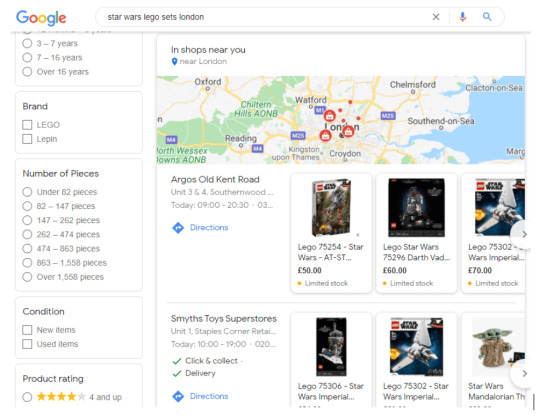
All of this is to say that assembling a well-rounded SEO team will be essential to top performance as multimodal search evolves. Consider nurturing in-house channel champions and/or engaging external product experts via an agency or freelance support, and coordinate to achieve business goals in search.
Borderless international SEO
In the coming year, three factors will become significant drivers for international SEO: the rise of borderless e-commerce, the maturity of AI translation tools, and the rollout of MUM.
Borderless e-commerce
Digital acceleration has changed our digital experience significantly.
The relevance of a business’s physical location, currency, and time zone is shifting, and the barriers to entry for brands to go global are being significantly reduced. Brick-and-mortar businesses still have a significant impact on local SEO and local pack SERPs, but customers are increasingly more willing (and more often, expecting) to buy from retailers outside their country. Research shows that tentative markets, where around 40% of consumers were willing to purchase from overseas sellers in 2016, had shifted to 55% willingness in 2021.
Shopify launched Shopify Markets at the start of Q4 2021, full of confidence in this global retail trend and its potential for sellers, meaning that competition here is likely to heat up in the coming months.
As SEOs, our task is to meet customers where they are, and this change in customer expectations brings opportunities for business growth. To get started here, consider tried-and-tested international SEO tactics alongside low-cost, low-friction market entry channels like free Google Merchant Listings.
If your international growth includes selling on top international marketplaces like Amazon, Wish, AliExpress, or eBay, consider optimizing your landing pages and on-site e-commerce E-A-T to build trust with new customers. Finally, think mobile-first for shoppers in Asia and other emerging markets.
In summary
All in all, I’m optimistic. As MUM matures we should see more varied content types emerge from around the web. Improvements to speed and security are a win for everyone. More layered SERP features help to demonstrate the importance of SEO. And building a borderless customer base helps to make brands more resilient in a changeable marketplace. Some of the changes we are likely to see are substantial, but they should move SEO in a positive direction.
0 notes
Text
The Top Tech SEO Strategies for 2022 and Beyond
Last year was an incredible year for Core Updates, and for changes to how SEOs improve page quality for users. Moving forward, we can expect to see increased diversification of SERPs, led by developments in Google’s algorithms, and new features from tools like Google Lens. These developments will change how we manage our SEO now and in the future.
Multimedia first
Why should you consider a multimedia-first SEO strategy?
MUM is the latest in Google’s suite of super-powerful algorithms, which help them to understand information in new and different ways. It runs alongside BERT, but it's actually much more powerful than BERT.
MUM stands for “multitask unified model”, and not only does it process natural language, but it does so in over 75 languages — and counting. It's also able to process text and images with a similar quality, and is increasing its ability to process video and audio in the near future. This means we’re likely to see the impact of this in the SERPs, specifically what they look like, which is also likely to shape some of the targeted algorithm updates in the future.
This shift in focus is a natural evolution of a mobile-first digital experience that allows users to engage with content dynamically using a mix of inputs, outputs, and tools, often simultaneously. Google’s push towards better understanding — and towards ranking media like image and video — will require SEOs to look at multimedia content with fresh eyes.
Which short-term multimedia optimizations should you prioritize in 2022?
Visual recognition for Google Lens
Google has invested significantly in image recognition solutions for almost 10 years, but they have recently picked up the pace and scale of its integration into everyday search.

As a result, improvements to and new uses for Google Lens have been front and center at flagship events like Google I/O and SearchOn during the last 12 months, while their future plans to move into health depend significantly on honing their visual search abilities.
In 2021, they added Google Lens directly into the search widget for Pixel, Android phones, and onto Chrome’s mobile search bar. Last year’s Google Lens updates included the ability to translate text in over 100 languages via AR and carry out targeted visual searches of screenshots. Add to this list of features their upcoming rollout of a MUM-enabled ability to “Add Questions” to Lens searches, and you can see that change is afoot.
How does Google Lens impact image SEO?
Standard image optimization elements like alt-text, schema markup, file names, image titles, and file sizes will continue to be important and relevant in regards to how search engines understand your image. Building upon this, though, elements like composition will also come to the fore. This means that SEOs might need to have more strategic conversations about what images look like, as well as how they’re rendered on a site.
This is because, while AI-driven image processing tools like Google Cloud’s Vision AI and Google Lens are developing rapidly, images that have clear composition will be better understood for visual search than images that are cluttered, complex, or partially visible.
Simply put, cleaner images mean that your content is surfaced with more relevant search results and business outcomes.
SEO value of image composition
Need to illustrate the point to stakeholders? Released in 2015, Vision AI’s image recognition tech underpins many of the functions of Google Lens, and their free demo tool can be used to demonstrate how images are interpreted at a high level. Pair this with real-time Google Lens results to illustrate where you should be concentrating your image optimization efforts as MUM matures.

Google's Vision AI API testing tool.
Case in point, in the diagram below, you can see two photos of the same enamel teapot as analyzed with Google Cloud’s Vision AI API testing tool and then with Google Lens.
In the image where you can’t see the handle and spout at the same time, the Vision AI interprets the photo as a Tableware object with 76% certainty and adds Kettle as the most relevant searchable label with 74% certainty. Conversely, the image with the teapot in the profile is understood as a Teapot with 94% certainty and given a Teapot label with 89% certainty.

How composition impacts Vision AI interpretation of images.
When we click through to the SERPs for kettle and teapot, we can see a clear difference in results. It is also clear that the latter is a much closer match to the actual object, thus more likely to satisfy customer needs, resulting in more click-throughs and driving better SEO for the site overall.

Left shows results for ‘Kettle’. Right shows results for ‘Teapot’
When we search the same images directly in Google Lens, the overall results are better: this time both are showing enamel teapots. But again, we see that the side profile photo is delivering near-exact matches to my IRL teapot. Thus, better photo composition equates to better search optimization.
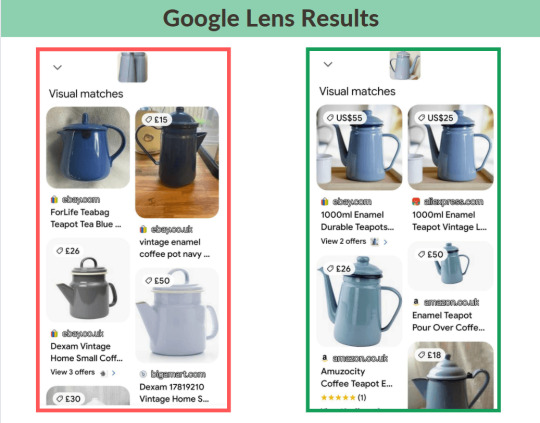
Better images give more relevant in Google Lens.
In practice, this means that while there may be a desire to fill a site with stylish lifestyle or Instagram-ready images, for SEO purposes, it is important to prioritize clean, — dare I say “boring” — images, particularly for transactional pages like product listings.
While this methodology is not necessarily new, the accessibility and integration of “search what you see” tools in the daily search experience will make image composition considerations for SEO a priority moving forward.
AI is allowing Google to make comparable strides with video and audio analysis, meaning investment in the knowledge of audio quality and video aesthetics could pay SEO dividends in the future.
Security for speed
Security and speed are both established ranking factors. During the great Core Web Vitals push of 2021, many came to understand that the two elements are closely linked. On an individual account level, I've seen server security optimization improve page performance for multiple clients. On a larger scale, when hosting platform Wix tripled their year-over-year CWV performance, enhancements like universal HTTP/2 to improve SSL times were critical to the task.
In the coming year, we will see Google prioritize security in its products and search services. Chrome promises the rollout of increased security and privacy tools, with updates that will include security features for <iframes> and cross-site navigation that add more checks as users transfer between links and use certain features.
This could give sites with top-tier security a competitive advantage for speed, page experience, and conversions in the coming year. And as the desktop page experience ranking update arrives in February 2022, the impact may be seen across many more domains.
Add to this trend the enthusiastic adoption of high-speed HTTP/3 by big tech players like Facebook and Google, and you can see that legacy tech will struggle to keep pace with user and bot expectations.
The use of HTTP/3, the latest HTTP protocol, has seen a fivefold increase across the web in the last year and is now live on about 25% of domains. Though this protocol is active on Cloudflare and many other top cloud providers, it is not yet standard. If you want to make the most of the benefits here, you may need to manually enable the update for your main server and/or CDN. And if you’re considering a new CDN or server partner in the coming year, this should be a deciding factor.
SEO specialisms for Google channel diversity
Google continues to reduce friction as users move between their dedicated channels and apps. In the process, they’re creating a more dynamic and niche SERP that requires SEO specialism to gain traction.
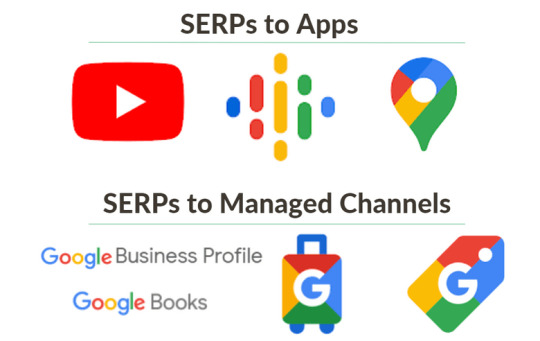
Click-throughs for some SERP results go to Google managed channels and apps.
From a user experience, this makes for rich mobile-friendly SERPs, which take users directly into high-performance apps like Google Maps and dedicated channels like Google Travel. Furthermore, it affords Google the opportunity to access and combine the information users need in a highly contextualized manner. Since Google-managed properties give them control over many informational feeds at once, enhancing and connecting existing channels will be essential to their aims to serve ever more nuanced search results.
While this has long been the preserve of transactional verticals like shopping and hotels, Google’s commitment to multi-modality means this is likely to become more prevalent amongst queries at the top of the funnel as well. This means SEO efforts must also be made to optimize profiles and performance within each of the most relevant channels in order to maximize visibility in the SERPs. Due to the rate of change for each channel, SEO generalism is increasingly less likely to build a critical mass for impact. Instead, coordinated teams for SEO specialisms are likely to see the most gains.
If we look at Local Inventory Ads (LIA) for instance, we can see optimizations for multiple channels converge to make a complex, high-value search feature. Introduced last year, this free and paid Google Shopping feature allows users to find products in stock at shops near their location. Google uses data and content from websites, Google Business Profiles, Maps, and Merchant Center to surface this information when users need it. Ongoing optimization for LIA requires expertise in each of these channels, running in tandem with a collection of SEO skill sets.
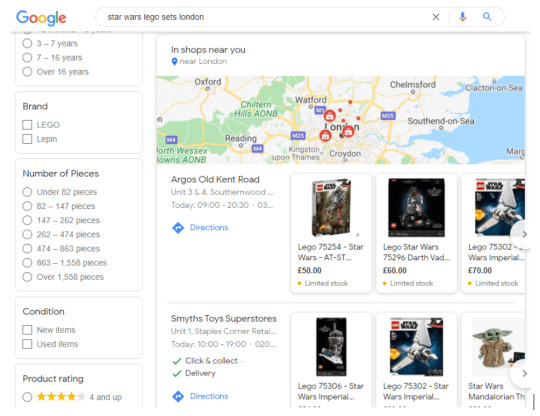
All of this is to say that assembling a well-rounded SEO team will be essential to top performance as multimodal search evolves. Consider nurturing in-house channel champions and/or engaging external product experts via an agency or freelance support, and coordinate to achieve business goals in search.
Borderless international SEO
In the coming year, three factors will become significant drivers for international SEO: the rise of borderless e-commerce, the maturity of AI translation tools, and the rollout of MUM.
Borderless e-commerce
Digital acceleration has changed our digital experience significantly.
The relevance of a business’s physical location, currency, and time zone is shifting, and the barriers to entry for brands to go global are being significantly reduced. Brick-and-mortar businesses still have a significant impact on local SEO and local pack SERPs, but customers are increasingly more willing (and more often, expecting) to buy from retailers outside their country. Research shows that tentative markets, where around 40% of consumers were willing to purchase from overseas sellers in 2016, had shifted to 55% willingness in 2021.
Shopify launched Shopify Markets at the start of Q4 2021, full of confidence in this global retail trend and its potential for sellers, meaning that competition here is likely to heat up in the coming months.
As SEOs, our task is to meet customers where they are, and this change in customer expectations brings opportunities for business growth. To get started here, consider tried-and-tested international SEO tactics alongside low-cost, low-friction market entry channels like free Google Merchant Listings.
If your international growth includes selling on top international marketplaces like Amazon, Wish, AliExpress, or eBay, consider optimizing your landing pages and on-site e-commerce E-A-T to build trust with new customers. Finally, think mobile-first for shoppers in Asia and other emerging markets.
In summary
All in all, I’m optimistic. As MUM matures we should see more varied content types emerge from around the web. Improvements to speed and security are a win for everyone. More layered SERP features help to demonstrate the importance of SEO. And building a borderless customer base helps to make brands more resilient in a changeable marketplace. Some of the changes we are likely to see are substantial, but they should move SEO in a positive direction.
0 notes